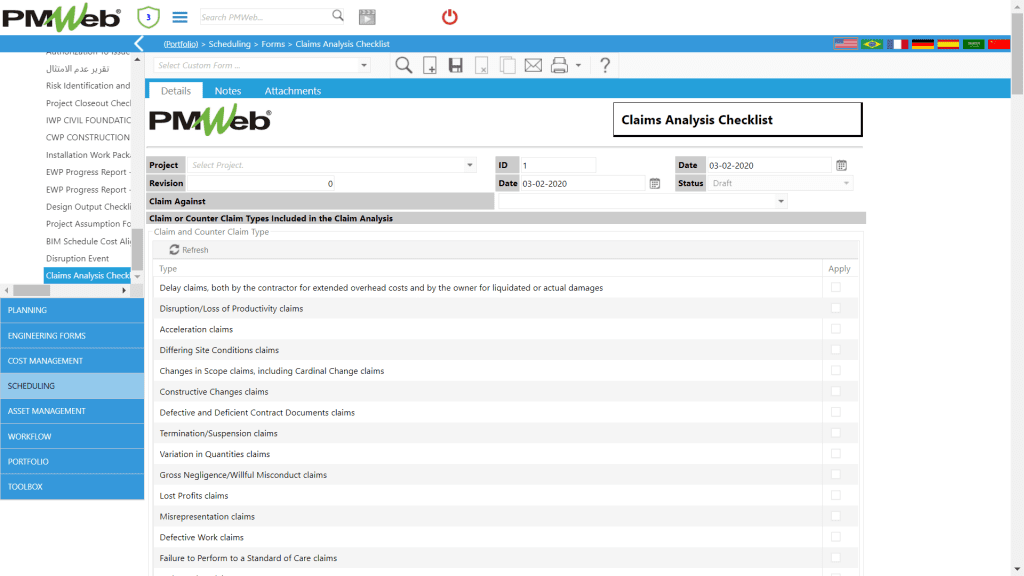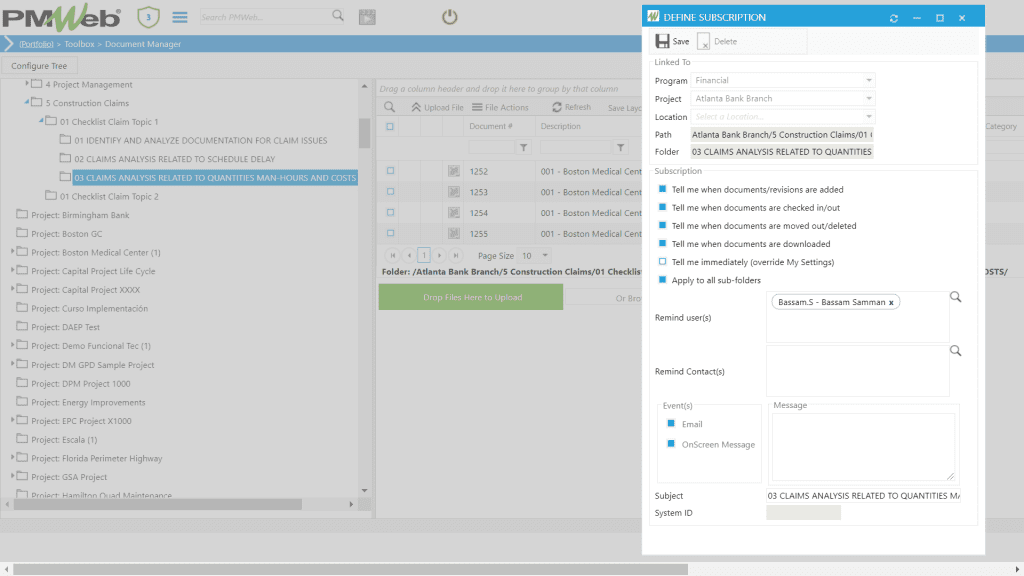One of the key challenges that face organizations involved in delivering capital projects when preparing or defending construction claims is how to ensure that their submission or response is complete and well supported to avoid the delays associated with incomplete or unsubstantiated claim submissions. The article published on February 27, 2020, by Richard J. Long, P.E., and Rod C. Carter, CCP, PSP titled “Construction Claims Analysis Checklist” provides an excellent example of how knowledge and experience can be shared and transferred by formalizing the use of checklists. The published article details how the experience of Long International, Inc. in the preparation and analysis of claims on engineering, procurement, and construction (EPC) projects can be used to either prepare or defend against claims, depending on the nature of the issues that comprise the claim.
Using a Project Management Information System (PMIS) like PMWeb the Construction Claims Analysis Checklist will become available to the project team as one of the many formal processes that could be implemented while delivering capital projects including EPC projects. The checklist will be developed using PMWeb visual form builder and will include five sections.
The first section will be used to capture the project name, date form created, checklist revision, status, and status date. Of course, additional details could be added such as the claim’s topic, contract reference, target date to complete the claims analysis among others. The second section will include the types of claims and counterclaims that are common to EPC projects and for which those need to be identified for the claim analysis being performed. This list should be always populated to reflect all emerging claims and counterclaims types that could become known to the team.

The third section of the Construction Claims Analysis Checklist will be used to prompt the project team on the details of the project documentation that need to be identified and analyzed for the claim types being analyzed. The content of this section is an example of an organization’s experience in preparing constructions. For each checklist item, the name of the assigned project team member to perform the identified task will be provided along with the status of the task and the date on when it was completed.

The fourth section of the Construction Claims Analysis Checklist will be used to prompt the project team on the details needed for analyzing the schedule delays that could have resulted from the claims being analyzed. For each checklist item, the name of the assigned project team member to perform the identified task will be provided along with the status of the task and the date on when it was completed.

The fifth and last section of the Construction Claims Analysis Checklist will be used to prompt the project team on the details needed for analyzing the quantities, man-hours, and costs that are associated with the claims being analyzed. For each checklist item, the name of the assigned project team member to perform the identified task will be provided along with the status of the task and the date on when it was completed.

PMWeb document management repository will be used to support the construction claims analysis. This will require setting a unique folder for each Construction Claims Analysis Checklist. This folder will include three subfolders. The first is for the documents that relate to the section titled “IDENTIFY AND ANALYZE DOCUMENTATION FOR CLAIM ISSUES”, the second for the documents that relate to the section titled “CLAIMS ANALYSIS RELATED TO SCHEDULE DELAY” while the third folder will be for the documents that relate to the section titled “CLAIMS ANALYSIS RELATED TO QUANTITIES, MAN-HOURS, AND COSTS”. There is also the option to create another level of subfolders for each one of those three subfolders for each checklist item. This folder breakdown structure provides the project team with a structured and secured process to upload and store all supporting documentation for the claim analysis. Of course, all those documents will be attached to the Construction Claims Analysis Checklist. The claims management team can subscribe to each folder to get notified when new documents are uploaded to the folder.

Of course, the documents uploaded and stored in PMWeb claims analysis folders will be attached to the Construction Claims Analysis Checklist form to enable the claims management team to access those documents from the form itself. Of course, the PMWeb default markup tool allows adding comments and shapes to those documents that are either in PDF or picture file format. In addition to attaching the uploaded and stored documents, PMWeb allows linking other PMWeb records as well as imported MS Outlook emails to the form.

Since usually there is no specific sequence of tasks that need to be followed in providing the needed details for the construction claims analysis, PMWeb Collaborate or Ad-Hoc Workflow will be used instead of the Workflow option in the Construction Claims Analysis Checklist. This Ad-Hoc workflow option will enable the initiator of the Construction Claims Analysis Checklist to invite the project team members that need to be involved in the construction claims analysis so they can provide their input and feedback while completing the tasks included in the checklists. The form initiator can set the privileges for the invited project team in terms of editing the record, edit notes, edit attachments, and be notified of team changes. The Collaborate or Ad-Hoc Workflow option provides a shared communication page for those invited project team members.




